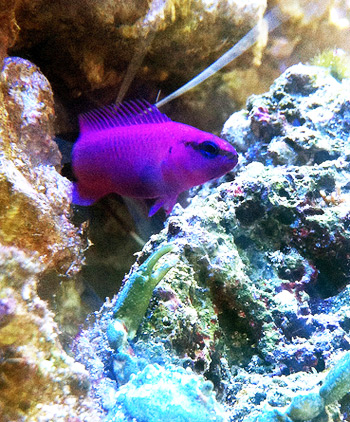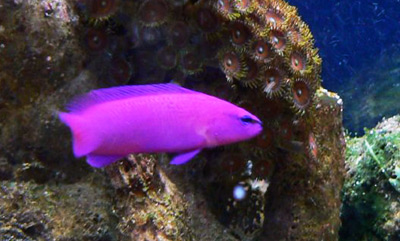Captive breeding of marine fishes has been a boon to our hobby in any number of ways, one of which is democratizing access to formerly really pricy species such as the orchid dottyback (Pseudochromis fridmani). While I wouldn’t characterize the current market price of this Red Sea species as “cheap,” it’s definitely in the realm of affordable for most hobbyists—and it’s hardiness, ease of feeding, manageable adult size, reef-friendliness, and relatively peaceful disposition (as dottybacks go, that is) more than justify the modest outlay of cash for a specimen.
Physical traits
P. fridmani is a small (reaching only around 2½ inches), streamlined fish with reddish-purple overall coloration and blue scale margins. A dark stripe extends diagonally from the snout upward through the eye. This species’ appearance in aquariums can vary markedly depending on the lighting scheme.
Feeding
You’ll find this P. fridmani is about as easy to feed as they come, especially if you choose a captive-bred specimen. Any small, meaty foods (the usual lineup—mysids, chopped seafoods, frozen formulations for small carnivores, etc.) will be accepted with gusto, as will small pellets (e.g., New Life Spectrum) and even flakes.
Housing
Minimum housing for P. fridmani is a tank in the ballpark of 20 to 30 gallons, and the aquascaping should consist of rockwork with lots of hidey holes to retreat into. Also, all dottybacks are good jumpers, so make sure the top of the tank is covered.
Compatibility

As mentioned, P. fridmani is quite peaceful as dottybacks go. It can even be kept in mated pairs and small groups. However, I wouldn’t risk this unless your tank is fairly sizeable and aquascaped to provide a lot of different territories for specimens to choose from. Also, be careful to avoid heterospecific tankmates that are very similar in size, shape, color, or the niche they occupy as they may be bullied (or, if more assertive, bully the dottyback).
By the way, be careful not to mistake this species for the very similarly colored magenta dottyback (Pictichromis porphyrea), which is arguably just as good looking but more likely to behave aggressively toward conspecifics and similar-looking heterospecifics, especially in smaller systems. You can distinguish P. porphyrea at a glance by the absence of the dark eye stripe found on P. fridmani.
If you’re planning to keep P. fridmani in a reef system, you won’t run into any problems there. This species is an ideal reef candidate, being totally inoffensive toward corals and other sessile invertebrates and posing a threat to none but the tiniest motile invertebrates.



